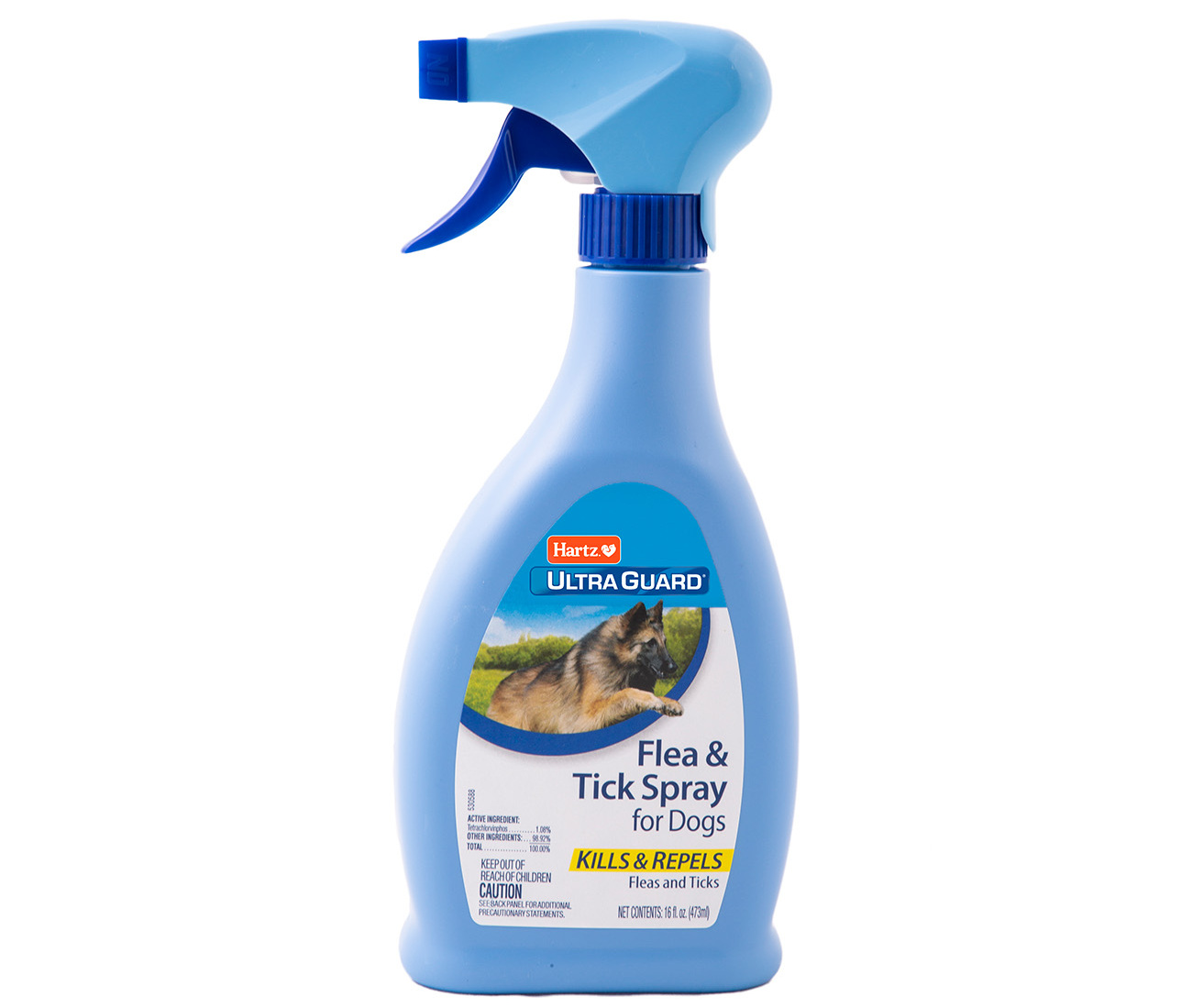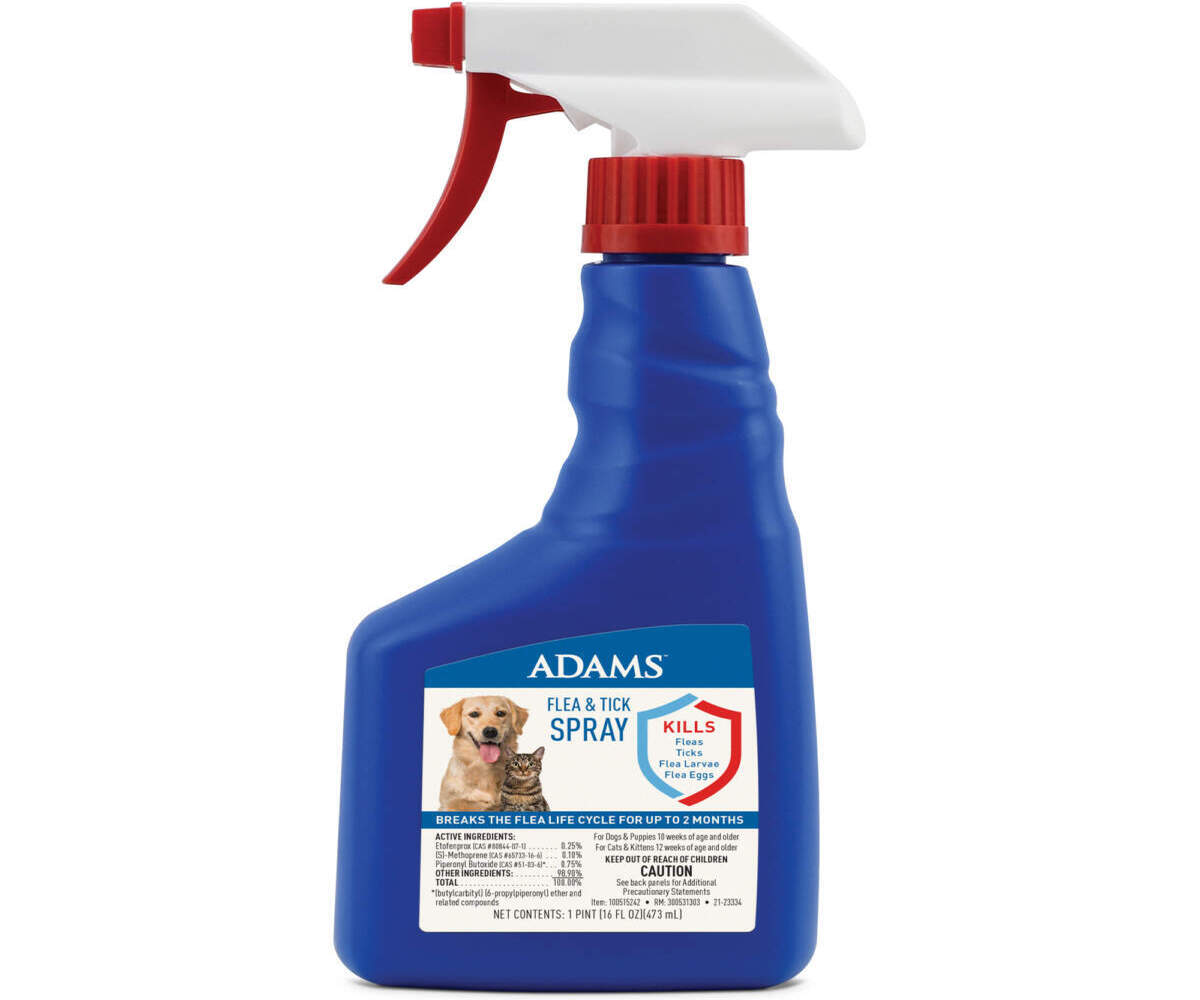Home>Health & Wellness>Common Health Issues>What Can I Spray On My Dogs To Repel Ticks


Common Health Issues
What Can I Spray On My Dogs To Repel Ticks
Modified: February 21, 2024
Protect your furry friend from ticks with safe and effective sprays. Learn how to prevent common health issues in dogs. Keep your pet healthy and happy!
(Many of the links in this article redirect to a specific reviewed product. Your purchase of these products through affiliate links helps to generate commission for Pawsomeoldies.com, at no extra cost. Learn more)
Table of Contents
Introduction
Ticks are not just a nuisance for dogs; they can pose serious health risks. These tiny parasites are capable of transmitting various diseases, including Lyme disease, ehrlichiosis, and anaplasmosis. As a responsible pet owner, it's crucial to take proactive measures to protect your furry friend from these potential threats.
One of the most effective ways to safeguard your dog from ticks is by using tick repellent sprays. These sprays are designed to deter ticks from latching onto your dog's fur and skin, reducing the risk of tick-borne illnesses. However, with the multitude of options available, ranging from natural remedies to commercial products, it can be overwhelming to determine the best course of action.
In this comprehensive guide, we will explore the various options for tick repellent sprays for dogs, including natural and commercial solutions. Additionally, we will delve into the application process, ensuring that you have all the necessary information to make an informed decision and protect your beloved canine companion from the dangers of ticks.
Read more: What Is The Safest Tick Repellent For Dogs
Understanding the Dangers of Ticks for Dogs
Ticks are not just pesky insects that irritate dogs; they pose significant health risks that every pet owner should be aware of. These tiny parasites are capable of transmitting a variety of diseases, some of which can have serious consequences for dogs. Lyme disease, for example, is a well-known tick-borne illness that can cause joint pain, lameness, and in severe cases, kidney damage. Ehrlichiosis and anaplasmosis are other common diseases transmitted by ticks, leading to symptoms such as fever, lethargy, and decreased appetite.
The dangers of ticks for dogs extend beyond physical health. The constant irritation caused by tick infestations can lead to discomfort and distress for our furry companions. Additionally, the potential financial burden of treating tick-borne illnesses can be substantial, making prevention a more cost-effective approach.
Furthermore, ticks are not just a threat to dogs; they can also transmit diseases to humans. This zoonotic potential adds an extra layer of concern, especially for households with children or individuals with compromised immune systems.
Understanding the dangers of ticks for dogs is crucial for pet owners to recognize the importance of implementing preventive measures. By being proactive in protecting our canine friends from these dangers, we can ensure their well-being and minimize the risks associated with tick-borne diseases.
In the following sections, we will explore various methods of tick prevention, including natural repellents, essential oils, commercial tick repellent sprays, and homemade solutions. Each approach offers unique benefits, and understanding their differences will empower pet owners to make informed decisions in safeguarding their dogs from the perils of ticks.
Natural Repellents for Ticks
When it comes to protecting our canine companions from ticks, natural repellents offer a compelling alternative to chemical-based products. These natural solutions not only help repel ticks but also minimize the exposure of dogs to potentially harmful synthetic ingredients. Here are some effective natural repellents for ticks:
1. Apple Cider Vinegar
Apple cider vinegar is a versatile natural remedy known for its various health benefits, including its ability to repel ticks. When diluted with water, apple cider vinegar can be used as a spray to deter ticks from latching onto a dog's fur. The strong scent and acidic nature of apple cider vinegar create an inhospitable environment for ticks, making it an effective and affordable natural repellent.
2. Neem Oil
Derived from the seeds of the neem tree, neem oil is a potent natural insect repellent. It contains compounds that disrupt the growth and reproduction of ticks, effectively reducing their presence on dogs. Neem oil can be diluted with a carrier oil, such as coconut oil, and applied to a dog's coat to provide long-lasting protection against ticks.
3. Cedar Oil
Cedar oil is renowned for its insect-repelling properties and is commonly used in natural tick repellent products. It works by disrupting the neurotransmitter function in ticks, ultimately leading to their demise. Additionally, the pleasant aroma of cedar oil makes it a favorable choice for pet owners seeking natural alternatives to chemical-based tick repellents.
4. Rose Geranium Oil
Rose geranium oil is a natural essential oil that has been found to be effective in repelling ticks. Its strong fragrance acts as a deterrent, making it less likely for ticks to attach to a dog's skin. When properly diluted, rose geranium oil can be applied to a dog's collar or directly onto their fur to provide protection against ticks.
5. Diatomaceous Earth
Diatomaceous earth is a natural powder derived from fossilized algae. It works by dehydrating and disrupting the exoskeleton of ticks, ultimately leading to their demise. When applied to a dog's environment, such as bedding or outdoor areas, diatomaceous earth can help reduce the presence of ticks and other pests.
By incorporating these natural repellents into a comprehensive tick prevention strategy, pet owners can effectively safeguard their dogs from the potential dangers associated with tick infestations. It's important to note that while natural repellents can be highly effective, they may require more frequent application compared to chemical-based products. Additionally, it's essential to consult with a veterinarian before using any new products, especially for dogs with pre-existing health conditions or sensitivities.
In the following sections, we will delve into the application of tick repellents, including essential oils and commercial sprays, providing pet owners with practical insights for protecting their furry companions from the perils of ticks.
Essential Oils for Tick Repellent
Essential oils have gained popularity as natural alternatives for repelling ticks and other pests. Their aromatic and potent properties make them effective in deterring ticks from latching onto a dog's fur and skin. When used appropriately, essential oils can serve as powerful tools in the fight against tick-borne diseases. Here are some essential oils commonly used for tick repellent:
1. Lavender Oil
Lavender oil is renowned for its soothing fragrance and versatile applications. In addition to its calming effects, lavender oil possesses tick-repellent properties. Its pleasant scent acts as a natural deterrent, making it less likely for ticks to attach to a dog's skin. When diluted with a carrier oil, such as coconut oil or almond oil, lavender oil can be applied to a dog's collar or directly onto their fur to provide protection against ticks.
2. Peppermint Oil
Peppermint oil is known for its refreshing aroma and natural insect-repelling qualities. Its strong scent disrupts the sensory receptors of ticks, making it an effective repellent. When properly diluted, peppermint oil can be used to create a spray or applied topically to repel ticks. However, it's important to use peppermint oil with caution, as it can be too potent for some dogs, especially when applied in high concentrations.
3. Eucalyptus Oil
Eucalyptus oil contains compounds that are effective in repelling ticks and other insects. Its strong scent serves as a deterrent, making it an ideal natural repellent for dogs. When using eucalyptus oil, it's crucial to dilute it properly with a carrier oil to avoid skin irritation. Additionally, eucalyptus oil should be used sparingly and never ingested by dogs, as it can be toxic in large quantities.
4. Lemongrass Oil
Lemongrass oil is a popular choice for natural tick repellent due to its citrusy and refreshing scent. It contains citronella, a natural insect repellent, making it effective in deterring ticks. When diluted with a carrier oil, lemongrass oil can be applied to a dog's fur or collar to provide protection against ticks. However, it's essential to monitor dogs for any signs of skin sensitivity when using lemongrass oil.
5. Cedarwood Oil
Cedarwood oil is derived from the wood of cedar trees and is known for its insect-repelling properties. Its woody and earthy aroma acts as a natural deterrent for ticks. When properly diluted, cedarwood oil can be applied to a dog's coat or used in a diffuser to create a tick-repellent environment. However, it's important to use cedarwood oil cautiously, especially for dogs with sensitive skin or respiratory issues.
When using essential oils for tick repellent, it's crucial to dilute them properly with a carrier oil to avoid skin irritation or adverse reactions. Additionally, pet owners should be mindful of their dog's individual sensitivities and consult with a veterinarian before using essential oils, especially for dogs with pre-existing health conditions or sensitivities. By incorporating essential oils into a comprehensive tick prevention strategy, pet owners can provide their furry companions with natural and effective protection against the perils of ticks.
Commercial Tick Repellent Sprays
Commercial tick repellent sprays offer a convenient and effective solution for pet owners seeking reliable protection against ticks. These products are formulated with active ingredients specifically designed to repel ticks and other pests, providing a practical and hassle-free approach to tick prevention for dogs.
When selecting a commercial tick repellent spray, it's essential to choose a product that is specifically formulated for use on dogs. These sprays are designed to be safe for canine application and are formulated to provide long-lasting protection against ticks. Additionally, many commercial tick repellent sprays are water-resistant, making them suitable for dogs that spend time outdoors or are frequently exposed to moisture.
The active ingredients in commercial tick repellent sprays often include compounds such as permethrin, pyrethroids, or fipronil, which are known for their efficacy in repelling ticks and other ectoparasites. These ingredients work by disrupting the sensory receptors of ticks, making it less likely for them to latch onto a dog's fur and skin. Furthermore, commercial tick repellent sprays may offer residual protection, providing extended coverage against ticks for a specified period after application.
In addition to their tick-repellent properties, many commercial sprays also offer protection against other pests, such as fleas, mosquitoes, and biting flies. This comprehensive approach to pest control ensures that dogs are safeguarded from a range of potential threats, making commercial tick repellent sprays a versatile and valuable tool in maintaining canine well-being.
When applying commercial tick repellent sprays, it's important to follow the manufacturer's instructions carefully. This includes ensuring proper coverage of the dog's coat and avoiding contact with sensitive areas, such as the eyes and mouth. Additionally, pet owners should be mindful of any potential sensitivities or allergies that their dog may have to certain ingredients, and it's advisable to perform a patch test before widespread application.
Ultimately, commercial tick repellent sprays offer pet owners a convenient and reliable method of protecting their dogs from the dangers of ticks. By incorporating these products into a comprehensive tick prevention regimen, pet owners can provide their furry companions with effective and long-lasting protection against tick-borne diseases, allowing them to enjoy a healthier and happier life.
Homemade Tick Repellent Sprays
Homemade tick repellent sprays offer a natural and cost-effective alternative for pet owners who prefer to create their own tick prevention solutions. These DIY sprays often utilize simple yet potent ingredients that are readily available and safe for canine application. By harnessing the power of natural elements, pet owners can craft homemade tick repellent sprays that provide effective protection against ticks while minimizing the use of synthetic chemicals.
Vinegar and Essential Oils
One popular recipe for a homemade tick repellent spray involves combining apple cider vinegar with essential oils known for their tick-repellent properties. The acidic nature of apple cider vinegar creates an inhospitable environment for ticks, while essential oils such as lavender, peppermint, or cedarwood contribute their potent scent and natural repellent qualities. When mixed in the right proportions and diluted with water, this homemade spray can be applied to a dog's coat to provide a protective barrier against ticks.
Read more: What Can You Spray On A Dog To Kill Fleas
Herbal Infusions
Another approach to creating a homemade tick repellent spray involves infusing dried herbs, such as rosemary, thyme, or sage, in boiling water to extract their natural repellent properties. Once the herbal infusion has cooled, it can be strained and transferred into a spray bottle for easy application. The aromatic and tick-deterring qualities of these herbs make the homemade spray an effective and natural solution for repelling ticks.
Citrus-Based Solutions
Citrus fruits, such as lemons and oranges, contain natural compounds that are known to repel ticks and other insects. By creating a homemade tick repellent spray using citrus peels and boiling water, pet owners can harness the natural repellent properties of citrus to protect their dogs from ticks. The resulting citrus-based spray can be applied to a dog's fur, providing a refreshing and effective barrier against tick infestations.
Herbal Vinegar Infusions
Herbal vinegar infusions involve steeping dried herbs, such as lavender, rosemary, or thyme, in apple cider vinegar to create a potent and natural tick repellent solution. The infused vinegar can be diluted with water and transferred into a spray bottle for convenient application. The combination of herbal properties and the acidic nature of vinegar makes this homemade spray an effective and aromatic defense against ticks.
By exploring these homemade tick repellent spray recipes and customizing them to suit their preferences, pet owners can take a proactive and natural approach to protecting their dogs from the dangers of ticks. These DIY solutions not only offer effective tick prevention but also provide pet owners with the satisfaction of creating safe and natural alternatives for their beloved canine companions.
Tips for Applying Tick Repellent on Dogs
Proper application of tick repellent is crucial to ensure its effectiveness and the safety of your dog. Here are some essential tips for applying tick repellent on dogs:
-
Choose the Right Product: Select a tick repellent that is specifically formulated for dogs. Ensure that the product is suitable for your dog's age, size, and health condition. Consult with your veterinarian if you have any concerns about which product to use.
-
Follow Instructions: Carefully read and follow the manufacturer's instructions for applying the tick repellent. Pay attention to the recommended dosage, application frequency, and any specific precautions or warnings provided by the manufacturer.
-
Spot Testing: Before applying the tick repellent to your dog's entire body, perform a spot test on a small area of their skin. This helps to ensure that your dog does not have an adverse reaction to the product. Observe the spot test area for any signs of irritation or discomfort before proceeding with full-body application.
-
Proper Coverage: When applying the tick repellent, ensure thorough coverage of your dog's entire body, including the legs, belly, and tail. Use your hands or a suitable applicator to massage the repellent into the fur, ensuring that it reaches the skin. Take care to avoid contact with your dog's eyes, mouth, and sensitive areas.
-
Avoid Overapplication: Use the recommended amount of tick repellent as specified by the product instructions. Overapplication can lead to excessive exposure to the active ingredients, potentially causing adverse reactions in your dog. If in doubt, consult with your veterinarian for guidance on the appropriate dosage.
-
Consider Environmental Factors: If your dog spends time outdoors or in areas with a high tick population, consider using a tick repellent that offers long-lasting protection. Additionally, reapply the repellent as recommended, especially after swimming or exposure to water.
-
Monitor for Adverse Reactions: After applying the tick repellent, observe your dog for any signs of adverse reactions, such as skin irritation, excessive scratching, or unusual behavior. If you notice any concerning symptoms, immediately wash off the repellent and seek veterinary advice.
-
Combining Preventive Measures: In addition to using tick repellent, consider implementing other preventive measures, such as regular grooming, maintaining a tick-free environment, and checking your dog for ticks after outdoor activities.
By following these tips for applying tick repellent on dogs, you can effectively protect your canine companion from the dangers of tick infestations while ensuring their safety and well-being. Always prioritize your dog's comfort and health when using tick repellent, and consult with a veterinarian if you have any concerns or questions about tick prevention for your dog.
Conclusion
Protecting our beloved canine companions from the perils of tick infestations is a responsibility that every pet owner should prioritize. Ticks pose significant health risks to dogs, ranging from the transmission of debilitating diseases to causing discomfort and distress. As such, implementing effective tick prevention measures is essential in ensuring the well-being and longevity of our furry friends.
In this comprehensive guide, we have explored various options for tick repellent sprays for dogs, including natural remedies, essential oils, commercial products, and homemade solutions. Each approach offers unique benefits, catering to the diverse preferences and priorities of pet owners. Natural repellents, such as apple cider vinegar, neem oil, and cedar oil, provide a safe and chemical-free alternative for those seeking natural tick prevention methods. Essential oils, including lavender, peppermint, and lemongrass, offer aromatic and potent solutions for deterring ticks from latching onto a dog's fur and skin. Commercial tick repellent sprays, formulated with active ingredients designed to repel ticks and other pests, provide convenient and reliable protection for dogs. Additionally, homemade tick repellent sprays empower pet owners to create their own natural and cost-effective solutions, utilizing simple yet potent ingredients.
Furthermore, we have provided practical insights for applying tick repellent on dogs, emphasizing the importance of choosing the right product, following instructions, and ensuring proper coverage while considering environmental factors and monitoring for adverse reactions. By incorporating these tips into the application process, pet owners can maximize the effectiveness of tick repellent while prioritizing their dog's safety and comfort.
Ultimately, the key to effective tick prevention lies in a comprehensive and proactive approach. By combining the use of tick repellent sprays with other preventive measures, such as regular grooming, maintaining a tick-free environment, and checking dogs for ticks after outdoor activities, pet owners can create a robust defense against tick-borne diseases.
In conclusion, safeguarding our dogs from the dangers of ticks requires diligence, awareness, and a commitment to their well-being. By leveraging the diverse options for tick repellent sprays and adopting a holistic approach to tick prevention, pet owners can provide their furry companions with the protection they need to lead healthy, happy, and tick-free lives.










